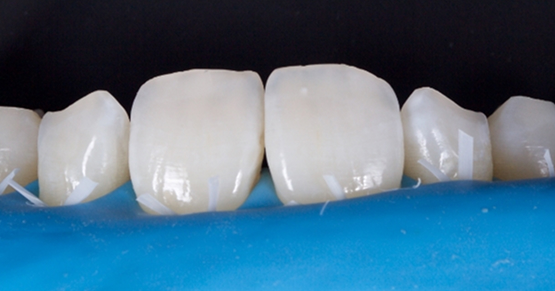How Many Implants in the Edentulous Maxilla?
How many dental implants would you like to see in the edentulous maxilla? Certainly there are many questions:
- Fixed or removable?
- Direct attachments to the implants or connecting bar?
- Are there options for phasing treatment — specifically adding implants in the future to modify the prosthesis to improve retention and stability?
- Do we even need dental implants?

What Is Your Strategy When Presenting Options to Your Edentulous Patients?
Strategically, the planning starts with the desired position of the maxillary central incisors as the reference point. Specifically, the incisal edge length, midline position, and the proportion of the central incisors set the tone for restoring the maxillary edentulous arch regardless of the materials and techniques involved.
Traditionally, six dental implants have been recommended for a dental implant-supported restoration in the edentulous maxilla. Eckert & Carr (2004) recommended six implants for the edentulous maxilla to provide options should an implant fail to integrate into the supporting alveolar bone. The idea is that something adverse could arise between when the treatment is presented to the patient and when we are ready to begin the definitive restoration. A contingency plan can help maintain the possibility of a dental implant-supported prosthesis for a patient with an edentulous maxilla. (Read Steps for Fabricating an Implant-Supported Prosthesis.)
While six dental implants would work for segmented crown and bridge restorations, eight dental implants in the edentulous maxilla would allow progressively longer fixed bridge segments while moving more anterior in the arch. Having dental implants in the #3, #4, #6, #7, #10, #11, #13, and #14 areas provides for single units in the maxillary molar areas with a four-unit fixed bridge in the anterior segment, where we would typically notice significantly less functional chewing forces. The segments allow the opportunity to limit the repair cost should a restoration chip or fracture occur.
There are anatomical limitations that may alter our preferred treatment plan. The general anatomy of the edentulous maxilla is shaped like a dome, with the platform of the dental implant oriented toward the facial/buccal aspect, while the apical aspect is more medial/palatally positioned.
The more implants planned, the more likely the apex of the adjacent dental implants to come too close or to touch … more likely for implants planned in the premolar — canine — lateral area. Another more common anatomical limitation for dental implant placement and position relates to the maxillary sinus’s position, height, and width.
The dental implant-supported fixed hybrid prosthesis (fixed detachable) has become more prevalent as it is applied for patients with an edentulous maxilla supported by as few as four implants. The rationale for working with four implants as the minimum is based on the improved surface characteristics and the well-defined surgical protocol related to dental implants.
Some would argue that additional implants only for the purposes of having a contingency plan would not fit a patient-centered treatment plan for a fixed hybrid prosthesis.
What About Removable Dental Implant Prostheses for the Edentulous Maxilla?
The discussion focuses on the three-dimensional position of the dental implants in the edentulous maxillary arch — specifically, the depth and angulation of the dental implants. Removable prostheses connected directly to the dental implants require relatively parallel placement with minimal angulation while providing support in the anterior and posterior segments. Dental implants with significant angulation issues can provide optimal support for removable over-denture prostheses by connecting bars with the appropriate amount of space for dental materials. Due to anatomic limitations, shorter implants are often required to place dental implants within the supporting bone (depth of placement) to provide room for restorative materials. (Read more about implant size selection.)
Typically, patients thinking about dental implants with a removable prosthesis are looking for the opportunity to limit the amount of material covering the palate. A removable prosthesis with an open palate with direct attachments to the implants or with a connecting bar requires the support of four dental implants.
What makes the edentulous maxilla interesting is that what works well for the edentulous mandible does not necessarily apply. Two or three implants in the maxilla does not seem to provide as satisfactory of a result for a removable over-denture prosthesis.
Of course, the short answer to how many dental implants is … it depends.
References
- Eckert, S. E., & Carr, A. B. (2004). Implant-retained maxillary overdentures. Dental Clinics, 48(3), 585-601.
- Brånemark, P. I., Svensson, B., & Van Steenberghe, D. (1995). Ten‐year survival rates of fixed prostheses on four or six implants ad modum Brånemark in full edentulism. Clinical Oral Implants Research, 6(4), 227-231.
SPEAR STUDY CLUB
Join a Club and Unite with
Like-Minded Peers
In virtual meetings or in-person, Study Club encourages collaboration on exclusive, real-world cases supported by curriculum from the industry leader in dental CE. Find the club closest to you today!

By: Doug Benting
Date: January 15, 2018
Featured Digest articles
Insights and advice from Spear Faculty and industry experts


